Privacy fence with two good sides
Give the neighbors the “good” side of a board fence. It can’t be climbed easily and they are less likely to complain when it’s a little taller than normal.
Use lath to cover gaps between boards. Even if there are no gaps when you first build it, there will be soon. Attach the lath on one side only or it will split as the boards pull apart over time.
This fence was built by the neighbor in preparation for selling the house, so they naturally wanted the good side.
Although this patio is a rental and many tenants aren’t concerned about someone peeking through the fence, it only takes a little more effort to create a patio that’s as private as a room inside the apartment -- unless someone takes the trouble to stand on something and look over the top anyway. Ground level next door is lower, so a six-foot fence with a cap is sufficiently high.

You can see them, and if they get close to the fence, they can see you.
Pre-drill lath or it will split as you screw it to the fence boards. I use 1" drywall screws. Staples didn’t work for me. You might have luck with a palm nailer, but lath splits easily.
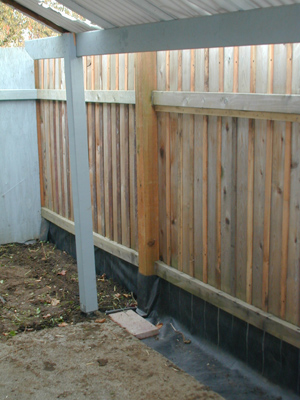
Along the bottom of this fence, landscaping fabric fills in the bottom foot of gaps between boards, while blocking weeds which come in from the neighbor’s yard.
Once reeds are in place, weeding between the two layers will be difficult. Blocking the soil with fabric or concrete avoids extra maintenance.
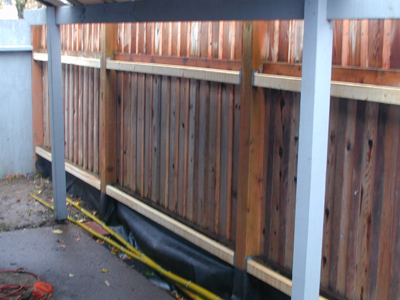
2x3 rails (horizontals) mounted flush with posts provide back supports for reeds.
Bamboo battens will screw into these rails, so their height is determined by esthetics more than by engineering needs.
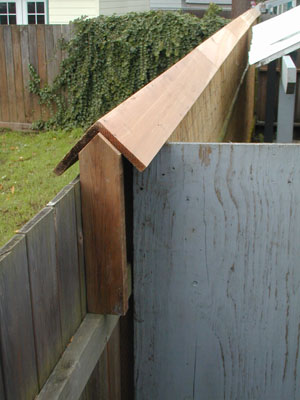
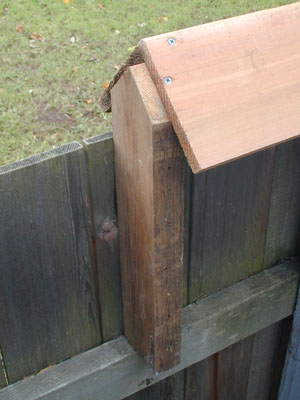
A cap made of 1x6 cedar fence boards protects the tops of the reeds and adds height.
Short 2x4s with 45 degree points are screwed to the fence boards wherever the cap boards join.

Reeds go up under the cap.
Without protection, reed tops become damaged by creatures of the night, cats, and the elements.
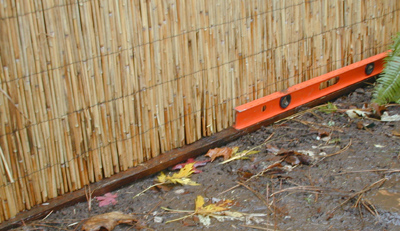
A level board to make the reeds even is essential.
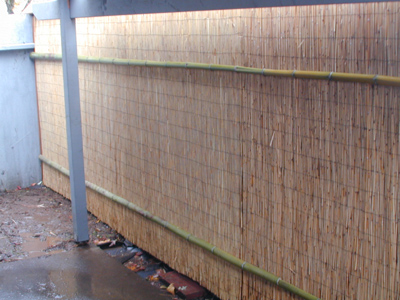
I was lucky to get two rolls of reeds which have the same stiching wire. They usually don’t line up as well as these do.
I harvested two 30-foot stalks of bamboo for the battens and split them in half lengthwise. Here’s how.
Drill holes at each joint, slightly larger than the screw diameter. Do not over-tighten or the bamboo will split.

The other end of the 27-foot fence.
The best reeds are polished: husks are removed before being sewed together. In a wet climate, this lengthens the life of the reeds because they don’t absorb and hold moisture, which leads to mildew and rot.
Also important is wire stitching that has been coated with plastic or vinyl. Without it, they will rust in a year, bleed in a distracting display, and fall apart in a few years. I never find both polished reeds and coated wire rolls, so I opt for unpolished with coated wire.
Rolls of split bamboo may also be available. The stalks will outlast the wire. They don’t stay as straight vertically unless the battens are screwed more often than at the joints, or if they are against something more solid such as chainlink fencing. They’re good against an unattractive solid board fence, as are reeds. Neither reed nor bamboo alone provides privacy, no matter what the makers claim. Privacy seems to be a relative term for some folks.
This is another work-in-progress which I plan to enhance over time. Your suggestions and links which may help others find materials, or explain how to proceed, will be appreciated.









